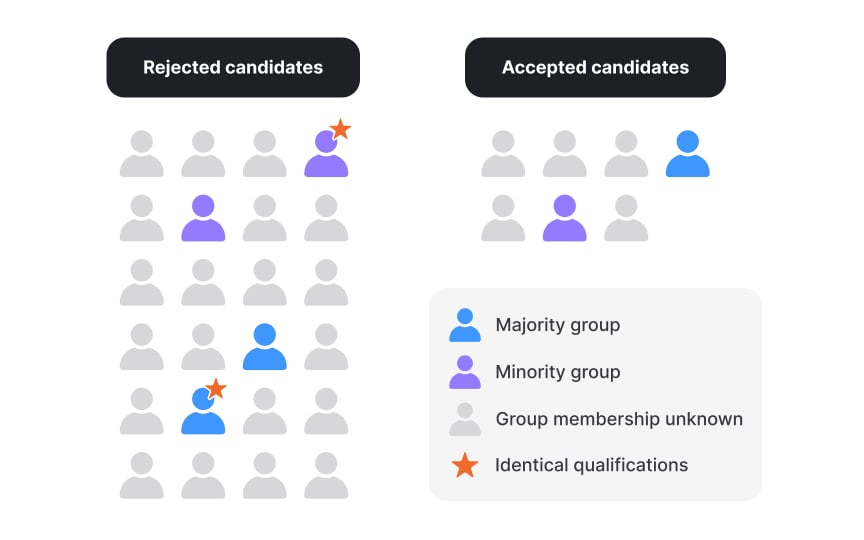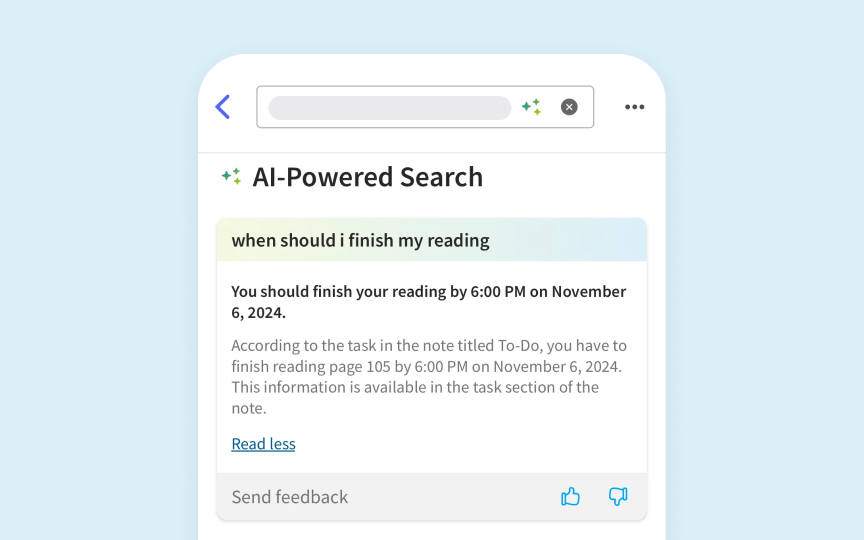Ethical & Societal Implications
Navigate the ethical challenges of AI to create fair, private, and responsible user experiences.
AI systems have important ethical responsibilities beyond just working well. When an AI system shows bias, it can silently block certain groups from opportunities or strengthen harmful stereotypes. For example, AI that screens resumes might prefer people from certain universities, or facial recognition might work worse for some skin tones. These aren't just technical problems but real barriers that affect people's lives and strengthen unfair social patterns.
Privacy is another key tension in AI design. Systems need data to create personal experiences, but collecting too much feels like watching users too closely. These problems come from complex interactions between technology and society that aren't easy to predict.
The impact is important as AI increasingly affects key parts of people's lives, from healthcare to financial opportunities. Addressing ethics isn't just about preventing problems but creating AI experiences people truly trust that add positive value to society.
- Data bias occurs when training materials don't represent all users equally, leading algorithms to perform better for the majority groups. For example, a healthcare AI trained primarily on data from male patients might miss important symptoms that present differently in women.
- Societal biases often occur because of inaccurate information taken from historical datasets
- Algorithmic bias emerges during model development when certain features receive disproportionate weight or when optimization targets inadvertently favor particular outcomes.
- Interaction bias happens at the user interface level when design choices create different experiences for different groups.[1]
For example, a voice assistant might struggle with certain accents, or a photo app might apply "beauty" filters that reflect narrow cultural standards. Designers must audit for bias at each phase: during data collection by ensuring diverse representation, during model development by testing across demographic groups, and during interface design by making systems adaptable to different user needs. Addressing bias requires ongoing vigilance rather than one-time fixes.
Several frameworks offer structured approaches to assess
- Demographic parity measures whether different groups receive the same proportion of positive outcomes, ensuring equal representation but potentially ignoring qualified differences. For example, a loan approval AI achieves demographic parity when it approves 30% of applications from all demographic groups, regardless of qualifications. However, this might ignore meaningful differences in qualifications.
- Equality of opportunity focuses on whether qualified individuals have equal chances of receiving positive predictions from the AI. A hiring AI demonstrates this when qualified candidates from all demographic groups have the same chance of being recommended for interviews.
- Counterfactual fairness evaluates whether changing only protected attributes (like gender or race) would alter the AI's decision. This means a resume screening AI should make the same recommendation for identical qualifications regardless of the applicant's demographic information.[2]
These frameworks help designers move beyond vague notions of "unbiased AI" toward measurable criteria. By implementing specific evaluation methods, comparing approval rates, qualified candidate success rates, or paired examples, designers can identify precisely where an AI system might be treating groups inequitably and take targeted action to address these disparities.
Fair
Here are practical strategies for diverse data collection:
- Audit your existing data to find gaps. Compare this to your target users to set clear representation goals. For new data collection, use stratified sampling to ensure all key groups are properly represented.
- Partner with community organizations to reach underrepresented groups, paying them fairly and explaining how their data will be used.
- When resources are limited, consider synthetic data generation, using algorithms like Generative Adversarial Networks (GANs) to create artificial but realistic examples that match the characteristics of underrepresented groups without requiring additional data collection.
- Apply data augmentation techniques to expand your existing data. For images, this means creating variations by changing brightness, contrast, or angle. For voice data, it includes adding background noise or altering speed. For text, it involves paraphrasing or translating content while preserving meaning.
- Add quality checks throughout your process: regularly measure demographic proportions, test performance across different groups, and set minimum representation requirements before training your model.
- Document your data collection methods and who is represented in your dataset using standard formats like model cards. This documentation helps everyone understand who is included in your training data.
AI-powered personalization creates engaging experiences but requires user data that raises privacy concerns. This creates a tension: more data typically enables better personalization, while stronger privacy protection limits available data.
Here are key approaches to balance personalization and privacy:
- Determine the minimum data necessary for effective
AI predictions and consider what specific data points actually improve model performance. Many AI systems collect more data than needed for accurate predictions. - Implement tiered AI features, where basic algorithmic recommendations work with minimal data while advanced AI personalization becomes available with additional data. For example, a streaming service could offer general recommendations or highly personalized
content based on viewing history. - Clearly explain AI-specific data usage. Instead of vague statements like "improve your experience with AI," specify exactly how the AI uses data: "Our recommendation algorithm learns from your viewing history to suggest similar content you might enjoy."
- Provide AI-specific privacy controls. Let users manage which behavioral patterns the AI can analyze rather than making all user data available to all AI systems within the product.
- Explore privacy-preserving AI techniques like federated learning (where models train on users' devices without sending raw data to servers) and differential privacy (adding noise to data to protect individual privacy while maintaining overall patterns).
- Prioritize AI personalization features with clear user benefits over those that create minimal value despite extensive data collection.
Clear communication about data practices builds trust in
Here are key approaches to data transparency in AI:
- Use plain language that explains how AI uses data in terms of concrete user benefits rather than abstract processing descriptions. For example: "This feature analyzes your photos to group similar
images " instead of "We process image data for classification purposes." - Include visual elements alongside text explanations. Icons, simple diagrams, and progressive disclosure help users understand complex information about AI data usage.
- Provide contextual notices at relevant moments, when an AI feature is about to collect new data types or when entering sensitive areas of an app, rather than burying everything in a lengthy privacy policy.
- Clearly distinguish between required and optional data collection for AI features. Let users know which functions will work with minimal data and which need more information to be effective.
- Help users understand when they're interacting with AI versus humans, what factors influence AI recommendations, and how their data shapes the system's behavior over time.
- Create structured privacy information that allows users to quickly find answers to specific questions about data collection, rather than forcing them to read comprehensive documents.
Privacy expectations around
Here are key approaches to contextual AI privacy:
- Map AI-specific privacy sensitivities for your application. Consider which AI functions users see as more invasive, like emotion detection versus simple object recognition in images, or sentiment analysis versus topic classification for text.
- Design AI data practices to match contextual expectations. For example, an AI assistant might process voice commands immediately without saving recordings for routine tasks, but ask permission before storing more sensitive health-related queries.
- Adjust AI transparency based on context. When an AI system is performing background tasks like spam
filtering , minimal disclosure is appropriate. For more sensitive applications likecontent moderation or health assessments, provide more detailed information about how AI analyzes user data.
Recognize that AI privacy contexts evolve. Features that initially seem intrusive, like facial recognition for photo organization, may become accepted as users understand the benefits and limitations.
Pro Tip: Create contextual AI privacy journeys that map how privacy expectations change throughout different user scenarios and system interactions.
Even well-intentioned
Here are key approaches to red team testing for AI systems:
- Create dedicated teams that actively try to break, manipulate, or misuse your AI, similar to security testing. For example, have testers attempt to make a
content generation AI produce inappropriate material despite safeguards. - Use adversarial testing to systematically probe AI weaknesses. Try inputs specifically designed to confuse
image recognition systems or test chatbots with inputs that might trigger harmful responses. - Include diverse perspectives on red teams. Developers often miss risks because they're focused on intended use cases. Include people with different backgrounds, technical specialties, and lived experiences to spot different types of vulnerabilities.
- Test for specific harm categories: bias and fairness issues, security vulnerabilities, potential for misuse, privacy violations, and safety concerns.
- Document all discovered issues, even those not immediately fixable. Build a knowledge base of AI vulnerabilities that helps identify patterns across different systems.
- Implement red teaming at multiple development stages, not just before launch. Early testing allows for fundamental design changes rather than just surface-level fixes.[3]
Here are the key approaches to predicting AI social impacts:
- Use scenario planning to develop multiple possible futures. For a facial recognition AI, create scenarios for beneficial use (finding missing persons), harmful use (unauthorized surveillance), and unexpected and undesirable consequences (changes in public behavior).
- Hold consequence scanning workshops that bring together diverse viewpoints to identify potential outcomes across different timeframes. Include technologists, ethicists, potential users, and representatives from communities who might be affected.
- Create “what-if” design exercises that explore how your AI might evolve or be used in unexpected ways. Think about edge cases and unintended audiences. For example, imagine a shopping recommendation algorithm being used by kids, leading them to discover and make expensive purchases without adult supervision.
- Develop impact assessment frameworks specific to your AI domain. For healthcare AI, assess impacts on patient autonomy, access to care, and clinical workflows. For
content moderation AI, consider effects on free expression, community safety, and creator livelihoods. - Map both direct impacts on users and indirect effects on non-users, communities, and institutions. An AI hiring tool affects not just applicants and employers but potentially entire job markets and communities.
References
- Fairness: Types of bias | Machine Learning | Google for Developers | Google for Developers
- Fairness: Counterfactual fairness | Machine Learning | Google for Developers | Google for Developers
Top contributors
Topics
From Course
Share
Similar lessons

Sustainability & Ethics in Design Thinking

Principles of Social Impact and Equity


























